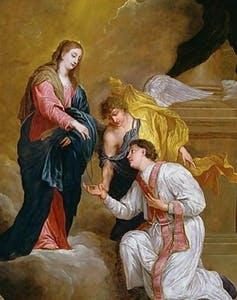Our modern Valentine's day with hearts and flowers, candy and cards, affords an interesting example of how hagiography, opens a new window can evolve over time.
The name Valentine is a rather popular one with several emperors, a pope, and multiple saints bearing the name. However, the Valentine of Saint Valentine's Day is generally considered to be one of two martyrs named Valentine, one a priest of Rome and the other a bishop of Terni. Both were said to be beheaded on February 14 during the reign of Emperor Claudius, and buried on the Flaminian Way, opens a new window. The actual year of St. Valentine's death varies by account, but it is always February 14 with the year believed to be between 269 and 273. These similarities have caused many scholars to suggest that the two stories refer to the same person or that one was later assigned the same death date by cult members unsure of their martyr's actual death date.
According to the Acta Sanctorum, opens a new window (which you can find in Latin at Archive.org, opens a new window), Valentine of Rome was arrested during the persecutions of Emperor Claudius, opens a new window. He was imprisoned in the home of a nobleman who challenged Valentine's faith and asked him to heal his blind adopted daughter to prove the existence of God. Through prayer, Valentine miraculously cured the girl and the 44 members of the household converted to Christianity. When Claudius learned of the miracle, he ordered that Valentine be beheaded. He was then buried just outside the Flaminian Gate of Rome.
Bishop Valentine of Terni, opens a new window was called to the scholar Crato's house to cure his son who had been crippled by a disease that contorted his body. Valentine tells Crato his child will be healed if Crato believes in Christ. The two men engage in debate and ultimately Crato agrees to convert if Valentine heals the child through his own faith. After a night of prayer, the child is healed and the family and household declare their belief in God. When the Roman senators hear about Valentine's healing of the child, Valentine is arrested and beaten with clubs. When he continues to refuse to denounce his faith, he is beheaded. His body was also buried along the Flaminian Way. Because Valentine cured a crippled child, he later became the patron of those afflicted with epilepsy.
These early stories of the martyrdoms of St. Valentine have little relation to the modern holiday that bares his name. There are several theories about how St. Valentine became the patron of lovers. One theory was that sending valentines on February 14 was connected to the pagan observance of Juno Februata, when boys drew the names of girls to begin courting. Butler's Lives of the Saints, opens a new window finds this claim "exceedingly doubtful." Others have suggested the connection to lovers comes from the Lupercalia, a mid-February Roman fertility feast.
In his 1981 article "St. Valentine, Chaucer, and Spring in February," Jack B. Oruch contends that it was Chaucer, he of the Canterbury Tales, opens a new window, that first associated bird songs, flowers, love, and the beginning of spring with St. Valentine's Day. In the 14th century most calendars considered February 7 or 23 to mark the beginning of the season. Numerous calendars declared that the birds begin to sing on February 12. Chaucer in his poem Parlement of Foules, opens a new window makes the connection between the mating of birds in the spring with St. Valentine. He contends that on St. Valentine's Day the birds chose their mates.
Whether Chaucer and other poets of the period truly began the romantic tradition or not, it was during this period that the relationship between St. Valentine and romance was solidified. Then the Victorians expanded upon it to create the holiday we know today, complete with chocolates, flowers, and cards.
The library has several resources on the lives of the Saints, including






Add a comment to: St. Valentine: Patron Saint of Lovers